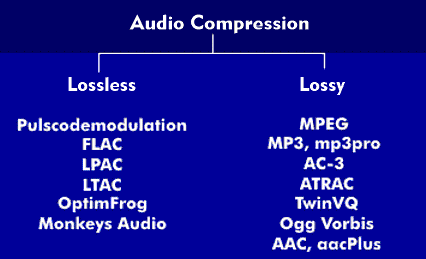audio compression
Audio compression is based on psychoacoustics and uses compression techniques that are based on human hearing behavior. For this purpose, the human hearing characteristic with the hearing threshold is taken into account, as well as the inertia of the ear, which is expressed in the technique of masking.
Audio compression is also about reducing irrelevancies. This means that sounds of the audio signal that the ear cannot perceive are not processed. This technique is implemented in most audio compression techniques
Lossy audio
compression Audio compression can be lossy compression or lossless compression. In general, lossy audio compression uses the Fourier transform, DCT transform, or FFT transform to transform the signals into the frequency domain and use subband coding to divide them into individual frequency bands. With this technique, each frequency band can have variable quantization and sample depth on its own.Thus, frequency bands with high audio density and dynamics can be digitized with high resolution, while others can be digitized with lower resolution. Well-known lossy compression methods are MPEG, MP3, AudioCode Number 3( AC-3), Adaptive Transform Acoustic Coding( ATRAC), TwinVQ, Ogg Vorbis, Advanced Audio Coding( AAC), aacPlus and mp3pro.
Lossless audio compression
The lossless compression aims at the reproduction in original quality and at the reduction of the digital audio data in order to save storage space. In lossless audio compression, decorrelation is used in the coder to eliminate dependencies in the audio signals. This is done with transform coding and linear prediction mechanisms, as used in Adaptive Delta Pulse Code Modulation( ADPCM), Lossless Predictive Audio Compression( LPAC), or Linear Predictive Coding( LPC). The prediction technique, predictive coding, is used for data reduction of audio signals. Only the difference of one sample to the previous one is stored.
A typical technique is adaptive differential pulse code modulation, in which the differential audio signals are adaptively quantized. The second method used in the coder is entropy coding of the independent symbols. Other compression techniques are similar to the ZIP technique ofdata. These methods include OptimFrog and Monkeys Audio.
In addition to ADPCM, which is standardized by the International Telecommunication Union( ITU), there are other methods for dynamic compression standardized by the ITU, such as the A-law method and the µ-law method.

